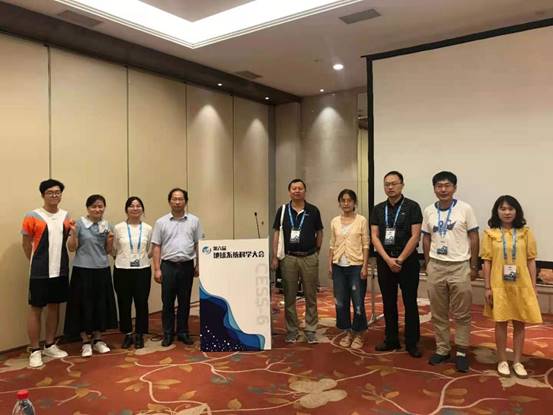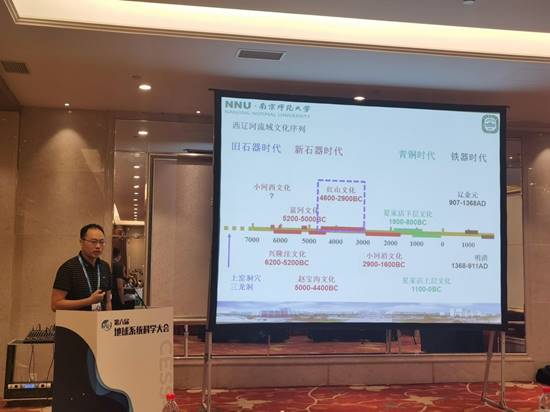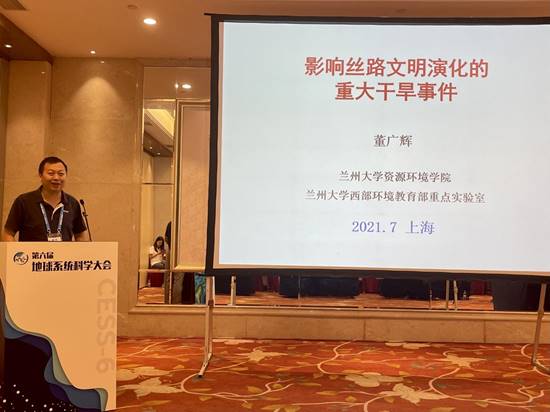from july 7 to 10, 2021, the 6th earth system science conference was held in shanghai. professor dong guanghui, professor chen jianhui, and associate professor ma minmin of our college jointly convened the 48th branch of the conference on the topic of "silk road civilization evolution and environment changes", two oral presentations were held on the afternoon of july 8 and 9. this sub-venue is one of the important academic activities organized by the environmental change and environmental archaeology professional committee of the chinese geographical society in 2021.
dozens of teachers and students from the institute for the history natural sciences, chinese academy of sciences, xi'an map publishing house, the institute of earth environment, chinese academy of sciences, the university of chinese academy of sciences, lanzhou university, nanjing normal university, the university of science and technology of china, qinghai normal university, guangzhou university, sichuan university, the institute of tibet plateau research, chinese academy of sciences participated in the event.
on the afternoon of july 8, the 48th branch venue was hosted by associate professor ma minmin, focusing on the evolution of civilization and environmental changes along the silk road. dr. chen wei made an opening quest presentation, combining the main civilizations of china and the mediterranean coast at the east and west ends of the ancient silk road, discussing the synchronicity of the evolution of the farmer’s calendar from the astrological calendar to phenological calendar, and the historical background of the unique calendar traditions of each; engineer bai jiangtao introduced the development of the belt and road thematic database construction and data mining analysis platform; doctoral student li ruo reported on the changes in the life model and the environment of ancient humans in the hexi corridor from the late neolithic to the early iron age, and broadcasted the prehistoric differences of ancient humans in the hexi corridor popular science animations of life scenes in the a period tried to popularize and publicize scientific research results in the field of environmental archaeology; researcher jin zhao introduced the work of " consolidating gully and protecting tableland " in the loess plateau in loess plateau area. taking dong zhiyuan as an example, pointed out that the highland the main reason for surface fragmentation reveals the main problems that affect the stability of the protection tableland project, and puts forward the system of “blocking-storing-draining-solidification” thinking of “blocking-storing-draining-solidification” and “ridge, land, pond (lake), management the 6-character prevention and control system of (ditch), well and dam; professor jiang hongen introduced the astana-halahezhuo cemetery in the jin and tang dynasties north of the old city of gaochang and the nearby badam and munnar cemeteries. the unearthed grains, fruits, and their processed products complement each other with the paper documents unearthed in turpan and cross-corroborate them. they reproduce the agricultural activities and plant utilization of turpan's ancestors during the jin and tang dynasties, as well as the cultural exchanges between the east and the west. finally, professor dong guanghui based on the latest progress in archaeological and paleoclimate studies combed the context of prehistoric intercontinental exchanges and the evolution of the silk road civilization and explained the impact of the mid-late holocene super arid climate on the key events of the evolution of the silk road civilization in different regions along the silk road.
the branch venue on the afternoon of july 9 was hosted by professor dong guanghui. associate professor jia xin gave an opening special lecture, introducing the relationship between climate change and human activities in the eastern part of the eurasian steppe, and the two warm and humid climates (holocene optimum period and medieval warm period) prevailing in the desert/sandy regions of northern china ) respectively correspond to the two cultural heydays in the xiliao river basin (hongshan culture and khitan liao period). the warm and humid periods promoted agricultural development and had a significant impact on the cultural prosperity of the region; phd student sun binggui introduced the northeast of iran in hulu the combined use of bronze and stone excavated at borj site in shan province in 2019-bronze age plant remains and phytolith results, combined with the results of animal remains, analysis shows that the natural environment in this area was relatively dry during the period 6500-5000 years ago, and it also existed at the same time water environment conditions suitable for the growth of aquatic plants. the way of human life should be animal husbandry, and the use of wheat crops; dr. lancuo zhuoma combined with archaeological data through the comprehensive application of multidisciplinary research methods, tried to reconstruct the paleolithic-historical period communication route on the qinghai-tibet plateau and analyzed its development and evolution and driving factors; dr. li teng introduced the latest development of the influence mechanism of climate change on the evolution of civilization in the qaidam basin in cooperation with professor dong guanghui’s team the research results have constructed a conceptual model depicting the “climate-hydrology-oasis-civilization” mechanism of this east-west exchange node area; dr. chen shengqian used almalou peat in the northwestern iranian plateau as the research object and compared it with the changes in regional precipitation over the past 100 years. it is found that the almalou peat fatty acid chain length index has a clear indication of precipitation, and reveals that the holocene in the region has the highest precipitation, the late holocene tends to be arid, and the wettest period basically coincides with the peat aquatic pollen content and the time when the forests began to expand in west asia; associate professor fan niannian introduced the impact of the formation and collapse of the barrier lake in wenchuan on the evolution of civilization and discovered that the formation and stable existence of the barrier lake promoted the emergence and development of the yingpan mountain civilization. the collapse at 4.7±0.1 ka caused yingpan mountain people to migrate downstream along the minjiang river valley.
the report in the sub-venue showed the participants the latest research progress in the field of silk road civilization evolution and environmental change and deepened the understanding among scholars from different units in related fields. the atmosphere of the sub-venue was warm, with scholars and graduate students enthusiastically asking questions and exchanges. in addition to the oral report sub-venue, a number of exhibition board reports were organized, which attracted the attention of many colleagues, and played a positive role in promoting academic exchanges and cooperation in the field of silk road civilization evolution and environmental change.



